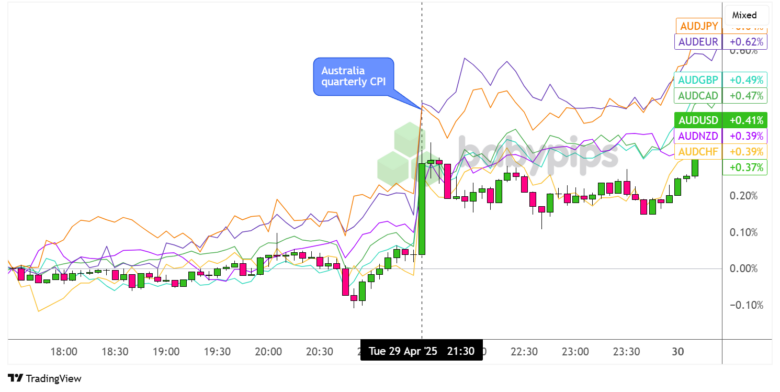Australian inflation remained unchanged annually but came in stronger than expected on a quarterly basis, reinforcing market expectations for a second rate cut by the Reserve Bank of Australia (RBA) at its May meeting but a more measured approach afterwards.
While annual inflation remained anchored within the 2-3% target range and core measures showed signs of easing, the quarterly reading suggested some lingering price pressures in the economy.
Key Takeaways:
- Headline CPI held steady at 2.4% year-on-year in March quarter, matching the December quarter reading but above the 2.2% forecast
- Quarterly inflation jumped to 0.9%, significantly higher than the 0.2% recorded in December
- Trimmed mean (core) inflation eased to 2.9% annually from 3.3%, in line with expectations
- The RBA’s target band for inflation is 2-3%, with current readings now comfortably within this range
- Higher quarterly figures were driven by electricity (+16.3%), education (+5.2%), and housing (+1.7%)
The quarterly jump in inflation was largely driven by specific factors including a 16.3% rise in electricity prices as rebate programs expired, a seasonal 5.2% increase in education fees, and a 1.7% rise in housing costs led by rental prices.
Services inflation, which has been a persistent concern for central banks globally, moderated to 3.7% annually from 4.3% in the December quarter, marking the lowest reading since June 2022.
Annual goods inflation crept up to 1.3% from 0.8%, reflecting some price increases in food and non-alcoholic beverages, which rose 3.2% year-on-year.
Link to Australia’s CPI Report (March 2025 Quarter)
Market Reactions
Australian Dollar vs. Major Currencies: 5-min
Overlay of AUD vs. Major Currencies Chart by TradingView
The Australian dollar strengthened broadly following the CPI release, with traders viewing the data as confirming the case for another RBA rate cut while not suggesting any need for aggressive easing. The currency gained approximately 0.4% against the US dollar, with similar gains against other major currencies.
After a bit of consolidation following the initial pop higher, AUD/USD posted a 0.41% lead on what appears to be another bullish wave hours after the release while AUD/JPY led the gains with a 0.62% rise. The Australian dollar also strengthened noticeably against European currencies, with EUR/AUD down 0.62% and GBP/AUD falling 0.49%.


